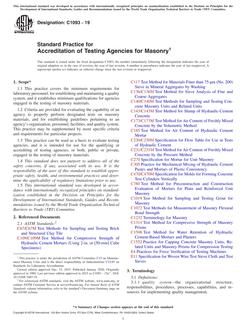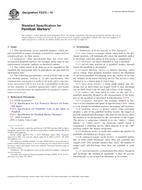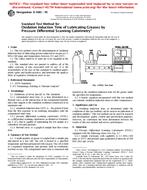1.1 This test method covers the determination of the cyclic strength (sometimes called the liquefaction potential) of saturated soils in either intact or reconstituted states by the load-controlled cyclic triaxial technique.
1.2 The cyclic strength of a soil is evaluated relative to a number of factors, including: the development of axial strain, magnitude of applied cyclic stress, number of cycles of stress application, development of excess pore-water pressure, and state of effective stress. A comprehensive review of factors affecting cyclic triaxial test results is contained in the literature (1).
1.3 Cyclic triaxial strength tests are conducted under undrained conditions to simulate essentially undrained field conditions during earthquake or other cyclic loading.
1.4 Cyclic triaxial strength tests are destructive. Failure may be defined on the basis of the number of stress cycles required to reach a limiting strain or 100 % pore pressure ratio. See Section 3 for Terminology.
1.5 This test method is generally applicable for testing cohesionless free draining soils of relatively high permeability. When testing well-graded materials, silts, or clays, pore-water pressures monitored at the specimen ends may not represent pore-water pressure values throughout the specimen. However, this test method may be followed when testing most soil types if care is taken to ensure that problem soils receive special consideration when tested and when test results are evaluated.
1.6 The values stated in either SI units or inch-pound units [presented in brackets] are to be regarded separately as standard. The values stated in each system may not be exact equivalents; therefore, each system shall be used independently of the other. Combining values from the two systems may result in non-conformance with the standard. Reporting of test results in units other than SI shall not be regarded as nonconformance with this test method.
1.7 All observed and calculated values shall conform to the guide for significant digits and rounding established in Practice D6026. The procedures in Practice D6026 that are used to specify how data are collected, recorded, and calculated are regarded as the industry standard. In addition, they are representative of the significant digits that should generally be retained. The procedures do not consider material variation, purpose for obtaining the data, special purpose studies, or any considerations for the objectives of the user. Increasing or reducing the significant digits of reported data to be commensurate with these considerations is common practice. Consideration of the significant digits to be used in analysis methods for engineering design is beyond the scope of this standard.
1.7.1 The method used to specify how data are collected, calculated, or recorded in this standard is not directly related to the accuracy to which the data can be applied in design or other uses, or both. How one applies the results obtained using this standard is beyond its scope.
1.8 This standard does not purport to address all of the safety concerns, if any, associated with its use. It is the responsibility of the user of this standard to establish appropriate safety and health practices and determine the applicability of regulatory limitations prior to use.

FIG. 1 Schematic Representation of Load-Controlled Cyclic Triaxial Strength Test Equipment
Product Details
- Published:
- 11/01/2011
- Number of Pages:
- 11
- File Size:
- 1 file , 170 KB
- Redline File Size:
- 2 files , 390 KB


